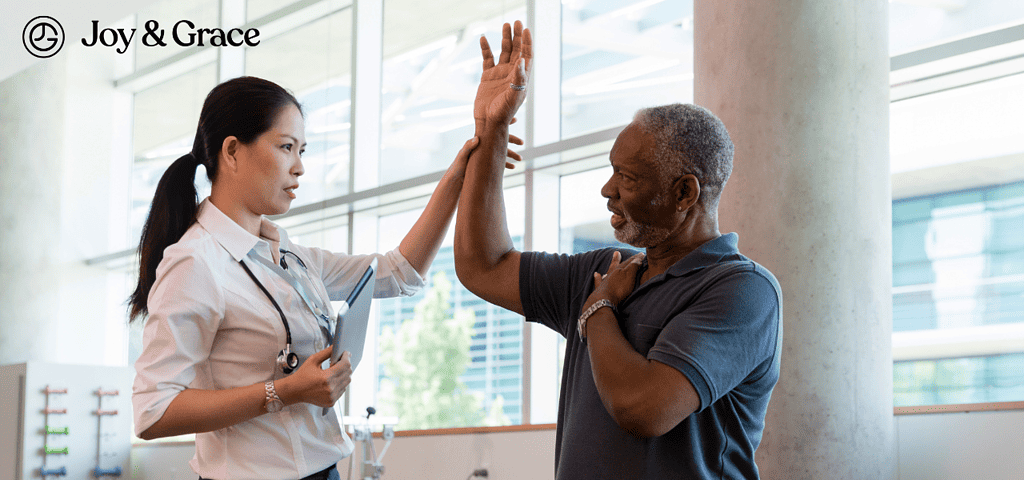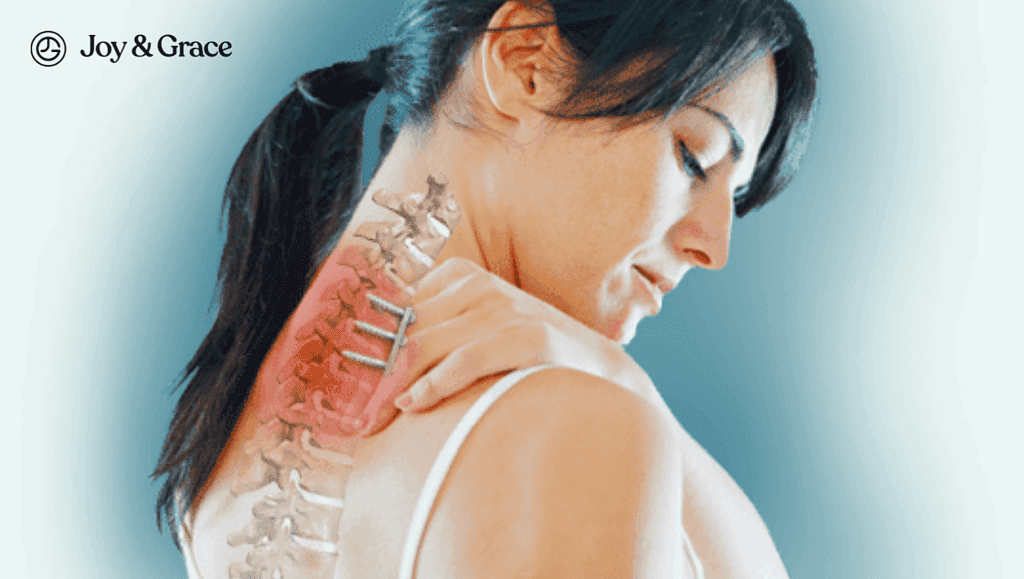Are you still experiencing shoulder pain years after your surgery? Well, you're not alone. According to a study, up to 22% of patients who undergo shoulder replacement report persistent shoulder pain.
If you've had shoulder surgery in the past and are still dealing with pain and discomfort, you're probably wondering what the heck is going on. You went through the surgery, did your physical therapy, and followed all the instructions from your doctor, so why are you still in pain?
In this article, we'll explore the causes of shoulder pain after surgery. We'll provide answers to common post-surgery recovery questions. So sit back, relax, and let's get to the bottom of your shoulder pain.
Why Does My Shoulder Hurt Years After Shoulder Surgery?
There are many reasons why you’re experiencing shoulder pain years after having your surgery.
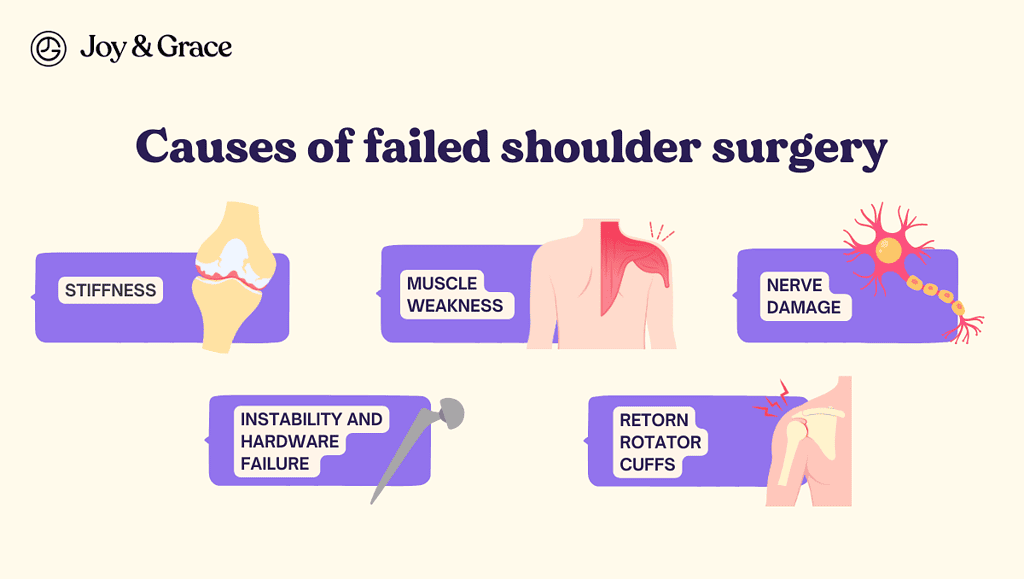
When your surgery fails to restore shoulder function or results in persistent pain, it’s usually termed a “failed shoulder surgery.” Failure of shoulder surgery can result from any of the following:
- Stiffness
Although stiffness is not pain, it may be mistaken for pain or frequently accompany it.
Postoperative shoulder stiffness is a common complication after shoulder repair. According to a study, shoulder stiffness occurs in up to 33% of patients who underwent shoulder surgery.
What’s interesting, though, is that stiffness actually protects you from retearing your rotator cuff. In the same study, rotator cuff repair was less likely to fail at 6 months in patients with shoulder stiffness. Although shoulder stiffness could disappear within 5 years, its protective effect can last up to 9 years after surgery.
- Nerve Damage
While it's not common, shoulder surgery can result in nerve damage. Several nerves in the shoulder area could potentially be affected during a surgical procedure.
In one study, only 16% of patients had suspected neuropathic pain. However, post-op shoulder stiffness can increase the risk of nerve damage.
- Muscle Weakness
After shoulder surgery, the shoulder muscles may become weaker due to the surgery or the post-surgery recovery process. This can lead to pain, as the weaker muscles work harder to perform everyday activities and movements. This results in overuse and inflammation.
Muscle weakness can also lead to shoulder instability, as the muscles are not strong enough to hold the shoulder joint together.
- Instability and Hardware Failure
Instability can occur if the surgery does not restore proper balance and stability to the shoulder joint. This can lead to pain, weakness, and a feeling of the shoulder "giving out."
Hardware failure can occur if the screws, plates, or other devices used to hold the bone in place during the healing process break or become loose. This can lead to pain, inflammation, and a loss of stability in the shoulder.
- Retorn Rotator Cuffs
A retorn rotator cuff occurs when the repaired tendons or muscles become partially or completely torn again. This can happen for various reasons, such as overuse, improper rehabilitation, or a larger or more complex tear.
Can Shoulder Surgery Cause Chronic Pain?
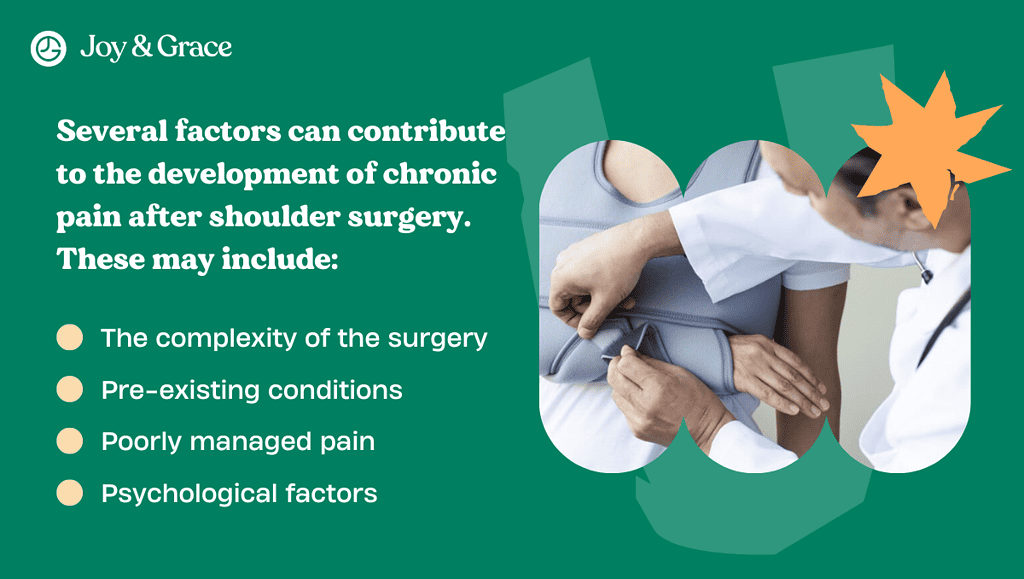
It is possible for shoulder surgery to cause chronic pain. While most people experience some pain after shoulder surgery, this pain typically subsides within a few weeks or months. However, the pain may persist in some cases and become chronic, lasting for months or even years after the surgery.
Several factors can contribute to the development of chronic pain after shoulder surgery. These may include:
- The complexity of the surgery
Some shoulder surgeries are more complex than others and may involve more extensive tissue damage. This can increase the risk of chronic pain.
Your reason for getting a shoulder injury may also be a factor in chronic pain. Patients who underwent shoulder replacement had a 29% chance of experiencing chronic pain.
- Pre-existing conditions
People with arthritis or nerve damage may be more prone to chronic pain after shoulder surgery. For example, patients with osteoarthritis had a 16% chance of experiencing chronic shoulder pain.
- Poorly managed pain
If the pain is not well managed during the early stages of recovery, it may become more difficult to control later on. Also, if you didn't do your rehab right after surgery, it could have slowed down your healing or caused more damage.
- Psychological factors
Chronic pain can also be influenced by psychological factors such as stress, anxiety, and depression.
Will My Shoulder Ever Be The Same After Surgery?
Understandably, you might wonder about your shoulder's long-term outlook after surgery. While every recovery can vary, it’s common for people to experience some improvement in their shoulder function after surgery.
Your recovery time will depend on the type of surgery you had, your age, overall health, and how hard you work at rehab.
What Are The Chances A Rotator Cuff Tear Will Heal With Surgery?
So, you've torn your rotator cuff, and you're wondering what your chances are of it healing with surgery. Well, a few factors can affect the chances of a successful surgery. For starters, the size of the tear can make a huge difference.
According to a study, rotator cuff repair had a healing rate of 56% within 12 months. However, this decreased with increasing size. Patients with small to medium tears had a 66% and 68% healing rate, while those with large to massive tears had a 27% and 48% healing rate, respectively.
According to the same study, age had a significant effect on healing and had the opposite effect on how fast people healed. This means that the rate of recovery goes down as age goes up.
It's also important to know that a full recovery from a torn rotator cuff can take several months and may require you to stick to your rehabilitation program. This is true even if your surgery went well.
How Long Does It Take To Recover And Get The Full Range Of Motion After Rotator Cuff Surgery?

Your rotator cuff can take several weeks or months to recover and regain a full range of motion after shoulder surgery. It takes about six weeks for the tendons to heal to the bone. Then, after about three months, they form a strong attachment to the bone. Finally, the tendons may take up to nine months to fully heal to the bone.
And as we mentioned earlier, recovery depends on several factors. This includes the type of surgery, age, overall health, and dedication to physical therapy and rehab.
In one study, the size of a rotator cuff tear also influences how long you can regain a normal range of motion of your shoulders. It can take a year for people with small or medium tears to fully regain their ability to rotate their arm outward (a movement called external rotation).
The amount of time it takes to fully regain the ability to lift the arm forward (called forward elevation) can also vary based on the size of the tear. It typically takes about 3 months for people with small tears to restore this movement fully. For those with medium tears, it may take up to 6 months to fully regain forward elevation.
However, people with large tears may experience some residual stiffness even after a year of recovery. If you had a large tear, you might want to invest in extra comfortable pillows for all the Netflix binges you'll have while your shoulder recovers.
How Do I Know If My Shoulder Surgery Failed?
It's normal to experience some pain, swelling, and stiffness after shoulder surgery. But if these symptoms are severe or worsening, it may be a sign that something is wrong.
If you are experiencing increased pain after surgery, it could be a sign of damage to the surgical site or surrounding tissue. Various factors, such as infection, poor healing, or injury during recovery, can cause this.
Swelling after surgery can also indicate excessive fluid accumulation, bleeding, or infection. Redness or warmth around the surgical site can also be a sign of infection or other complications. This can be a sign that the surgical wound is not healing correctly.
Stiffness or difficulty moving your shoulder after surgery can also be a sign of damage. Scar tissue that forms around the surgical site can restrict movement, but it also could be due to poor healing or other complications.
If you experience numbness, tingling, or weakness in your arm or hand after surgery, this could be a sign of nerve damage. These symptoms can occur if a nerve is compressed or damaged during the surgery or if the nerve is healing poorly after the surgery.
Overall, it's essential to monitor your symptoms after shoulder surgery closely. If you notice any of these signs, contact your surgeon immediately for further examination and appropriate treatment.
How Do I Know If I Re-Injured My Rotator Cuff After Surgery?
If a rotator cuff repair fails, the tendons or muscles have not healed properly, and the tear has not been fully repaired. Possible causes include poor surgical technique, improper rehabilitation, or more complex tears.
The symptoms of a failed rotator cuff repair may include:
- Persistent pain in the shoulder area, which may be worse with certain movements or activities.
- A limited range of motion in the shoulder, which may make it difficult to reach overhead or behind your back.
- Weakness in the shoulder and arm, which may make it difficult to lift or carry objects.
- Popping or clicking sounds coming from the shoulder, which may be caused by the torn tendons or muscles rubbing against each other or the bone.
- A visible deformity in the shoulder area, which may include a bump or lump on the shoulder.
If you are experiencing any of these symptoms, it's important to schedule an appointment with your doctor for an evaluation. They may order imaging tests, such as an MRI, to confirm if the repair has failed and may recommend revision surgery.
When Does Shoulder Pain Go Away After Surgery?
The recovery time for shoulder pain after surgery can vary depending on the type of surgery and the individual's overall health. Generally, it can take several months for the shoulder to fully heal and for the pain to subside. As we mentioned earlier, it may take up to 9 months for your shoulders to feel completely normal.
What Should I Expect After Shoulder Surgery?
After shoulder surgery, expect to come home with a sling or shoulder immobilizer. These are to keep your shoulder immobile and stable. Wait for your doctor to tell you it's okay to take off the sling and immobilizer. However, you can loosen the sling when you’re just at home.
While you’re recovering, you may also need to use your good arm to support or move the recovering arm. Always wait for your doctor to tell you it’s okay to move the recovering arm without any support.
Your doctor may also refer you to a physical therapist to help you gradually regain your strength.
Some exercises your physical therapist may suggest include:
The Pendulum exercise is a great way to strengthen your shoulder muscles, especially the deltoids. All you need is a flat surface like a table or counter to put your weight on for this exercise.
- To start, stand with your feet about shoulder-width apart and slightly lean forward. Put one hand on a table or counter for support.
- Put your free arm down by your side.
- Move your arm gently forward and back, then side to side, and then in a circle.
- Switch arms. Repeat everything again.
- When doing this exercise, always keep your back straight and your knees bent.
- Aim for two sets of ten reps, five to six days a week.
The Crossover Arm Stretch is a simple exercise that works the posterior deltoid muscles in your shoulders. The back of your shoulder will feel this stretch. For this exercise, you only need your own body weight.
- Stand with your feet about shoulder-width apart and loosen your shoulders.
- Pull one arm across your chest gently, and use the other hand to hold your upper arm.
- Keep your grip for 30 seconds before changing sides.
- Do the stretch four times on each side, five to six times a week.
This is a great way to stretch and strengthen the muscles in your shoulders called subscapularis. For this exercise, you'll need a light stick, like a yardstick or a wooden ruler.
- Stand up with your feet shoulder-width apart.
- Hold the stick behind your back with one hand and take a light hold of the other end with the other.
- Pull the stick horizontally, stretching your shoulder until you feel a pull without any pain.
- The stretch should be held for 30 seconds.
- Take 30 seconds to relax before changing sides.
- Do the stretch four times on each side, five to six times a week.
- Don't lean over or turn to the side as you pull the stick.
This is a great way to strengthen and stretch your rotator cuff muscles. Again, you'll need your yardstick or ruler.
- Stand with your feet about shoulder-width apart and hold the middle of the stick in front of you with one hand, and cup the other end with your other hand.
- Keep your elbow close to your side and push the stick in a horizontal direction.
- The stretch should be held for 30 seconds.
- Take 30 seconds to relax before changing sides.
- Do the stretch four times on each side, five to six times a week.
- Make sure your hips are facing forward and don't turn.
This workout doesn't need any tools, just a flat, firm surface like a bed or couch.
- Lay on the shoulder that hurts and bend your arm up at a 90-degree angle.
- You can be more comfortable by putting a pillow under your head.
- Use your other arm to pull down on your hurt arm.
- Stop when you can feel a stretch in the back of your affected shoulder.
- For 30 seconds, stay in this position.
- Let your arm hang loose for 30 seconds, then do it again.
- Make sure you don't bend your wrist or put pressure on it.
- Aim to do this stretch three times a day, four times a week.
External Rotation with Arm Abducted 90°
To do this exercise, you'll need a stretchy band with a comfortable amount of resistance. You can also do this workout at a gym on a weight machine.
- Make a loop with the band and tie it to a doorknob or something else stable.
- Stand in front of the doorknob and hold the band with your elbows bent at a 90-degree angle and raised to the level of your shoulders.
- With your elbows and shoulders in line, slowly raise your hand by rotating your forearm back until your hand is level with your head.
- Slowly bring your arms down and do the move again.
- Aim for three sets of eight reps, three days a week. Keep your elbow in line with your shoulder as you do the exercise.
You will need a resistance band or a light dumbbell for this exercise. You can do this with a weight machine at the gym, just like the last exercise. This exercise will work your shoulders and chest.
- Make a loop with the band and tie it to a doorknob or something else stable.
- Stand next to the doorknob, positioning your body such that the recovering shoulder is closest to the doorknob.
- Hold the band with your elbows bent at a 90-degree angle.
- Pull on the band by bringing your arm across your body while keeping your elbow close to your side.
- Slowly bring your arm back to your side, and then do it again.
- Aim for three sets of eight reps on each side, three times a week.
- Start by lying on your hurt arm on a stable, flat surface.
- Put a pillow under your head to straighten your spine.
- Use the injured arm to hold the weight. Hold the weight horizontally, with your elbows bent at a 90° angle, in the starting position.
- Keep your elbow bent and close to your body. Slowly rotate your injured arm towards your torso to raise the weight to a vertical position.
- Drop the weight back down slowly. Make sure to use the right form by keeping your elbow bent and close to your body the whole time.
For this exercise, you'll need a resistance band, a light dumbbell, or a weight machine, just like you did for the last one.
- Loop the elastic band and tie its ends together. Then, tie the loop to a doorknob or something else that won't move.
- Stand next to the doorknob and hold the band at your side with your elbow bent.
- Slowly and deliberately turn your arm outward.
- Slowly bring your arm back to your side and do it again.
- When you pull your elbow back, be sure to squeeze your shoulder blades together.
- Start by laying on your side on a firm, flat surface.
- Put the arm that isn't hurting under you and cradle your head.
- Hold your hurt arm against your side with your elbow bent at a 90-degree angle.
- From this position, keep your elbow against your side and slowly turn your injured arm outward to raise the weight to a vertical position.
- Slowly lower the weight down again while counting to 5.
Aim for 3 sets of 8 reps when you first start this exercise. As you get stronger, you can do 12 repetitions. This exercise should be done three times a week.
The muscles on the front of your upper arm get a workout from this routine. To do this exercise, you will need a weight that allows you to do 3 sets of 8 reps.
- Stand up with your feet shoulder-width apart, using your hand on your hurt arm to hold the weight.
- Slowly bring the weight up to your shoulder by bending at the elbow, keeping your elbow close to your side.
- Hold for two seconds, and then slowly bring it back down.
- Be sure to do the exercise slowly and not to swing your arm quickly.
- Repeat
You can slowly add up to a maximum weight of 15 pounds. When you add weight, you should start over with 3 sets of 8 reps. Repeat this three times a week.
This exercise is meant to strengthen the triceps muscles at the back of your upper arm. To do this exercise, you'll need a weight that lets you do 3 sets of 8 repetitions.
- Start by standing up straight and putting equal weight on both feet.
- Raise one arm, bend your arm back at the raised elbow, and hold the weight behind your head with the other arm.
- Bring your free arm across your torso, and place it on your upper arm to support it.
- Raise your lower arm at your raised elbow, slowly bringing the weight over your head.
- Hold for two seconds, then slowly lower the weight behind your head and do it again.
- Keep your stomach muscles tight, and try not to arch your back while you do the exercise.
You can add 1 pound at a time to the weight until it reaches a maximum of 10 pounds. Every time you add more weight, go back to 3 sets of 8 reps.
It’s important to always do the suggested exercises, even when difficult, as these exercises will help you recover faster. It will get easier over time. You have to do them every day, making sure to follow your therapist’s instructions. Over time, you should be able to perform these exercises outside of your physical therapy sessions.
What Can I Not Do After Shoulder Surgery?
You may need to avoid a few activities after shoulder surgery, at least until your surgeon gives you the okay to resume them. These may include:
- Lifting heavy objects
You will likely need to avoid lifting heavy objects for at least a few weeks after surgery, as this can strain the surgical site and hinder healing.
- Participating in high-impact activities
Activities that involve high-impact or repetitive motion, such as running or tennis, should be avoided. Wait until your surgeon gives you the thumbs up to resume them.
- Engaging in activities that involve reaching overhead
Reaching overhead or behind your back can put a strain on the surgical site and should be avoided until your surgeon gives you the okay to do so.
- Driving
You may need to avoid driving after surgery, as it can be difficult to operate a vehicle with limited mobility in your shoulder safely.
- Leaning on the arm
Avoid putting any pressure or extra weight on the recovering arm. This also means avoiding any activities that require you to push or pull with the affected arm.
- Sports
It’s best to avoid any sport that requires you to reach overhead or use your arm forcefully. This includes sports like basketball, volleyball, boxing, and tennis. It’s also important to avoid weightlifting and contact sports like soccer. Ask your doctor when it’s okay to engage in the activities you previously enjoyed.
It's important to follow your surgeon's instructions and avoid any activities that may cause strain or discomfort. This will help ensure a successful recovery and minimize the risk of complications.
What Can I Do To Relieve Pain After Shoulder Surgery?
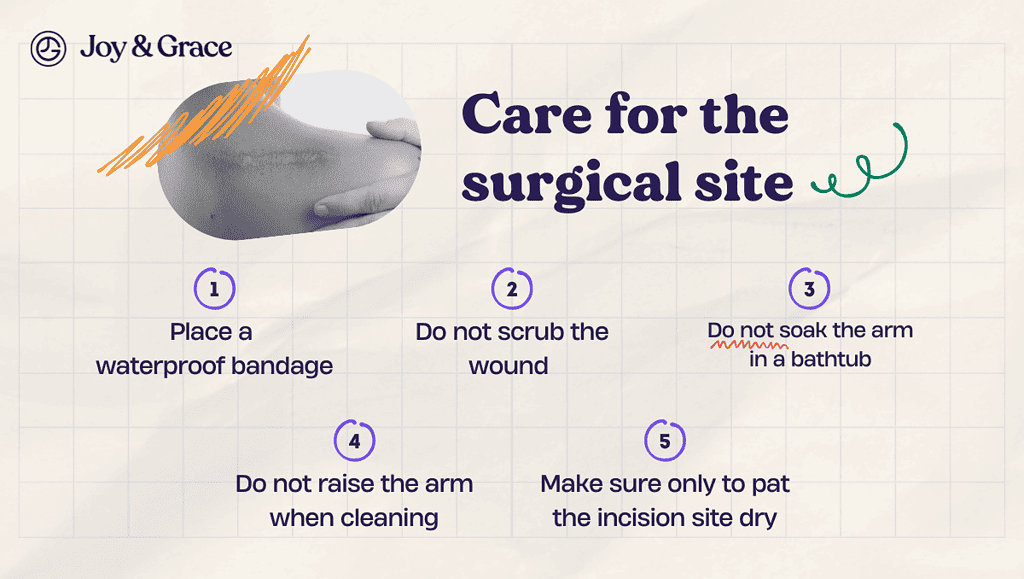
There are several things you can do to help relieve pain after shoulder surgery, including:
- Keep the rest of your arm moving
It’s important to keep your hand, wrist, and fingers moving even while you’re using the sling. This is to maintain proper circulation. It’s suggested to do it 3–4 times a day.
- Taking pain medication
If your prescribed pain medication runs out, your doctor may recommend taking over-the-counter pain medication to help relieve pain.
- Care for the surgical site
It’s important to keep the wound very clean to avoid infection. If you feel like the bandage needs changing, ask your doctor if you can do it yourself. If your doctor gives you the OK to shower, make sure to:
- Place a waterproof bandage
- Do not scrub the wound
- Do not soak the arm in a bathtub
- Do not raise the arm when cleaning. You can clean the armpit of the affected arm by bending forward and letting the arm hang freely.
- Make sure only to pat the incision site dry.
- Ice therapy
Applying an ice pack to the surgical site can help reduce swelling and ease the pain. Protecting your skin from the cold is important, so wrap a towel around the ice pack.
- Rest
Resting the shoulder as much as possible is important to allow the surgical site to heal. This may mean avoiding certain activities or movements that strain the shoulder.
Physical therapy can help improve the range of motion and reduce pain after shoulder surgery. A physical therapist can show you exercises that will help improve strength and flexibility in the shoulder.
- Strengthening Exercises
Gradual strengthening exercises with a physical therapist will help you regain shoulder strength. Over time, you will reduce the pain.
Alternating heat and cold therapy can help reduce shoulder pain and stiffness. If you’re looking for a great heating pad to help ease your pain, we’ve got the perfect one for you.
- Sleep in a comfortable position
Sleeping with a pillow between your arm and body can help keep the arm elevated and reduce pain. It’s recommended that you don’t lie flat while you sleep, so consider sleeping on a reclining chair or raising your upper body with a pillow.
Not all of these methods may work for everyone, so it's important to discuss with your doctor which options would be best for you. It's also important to follow your surgeon's instructions for postoperative care. This includes when to begin therapy and return for follow-up appointments.
Takeaway
In conclusion, shoulder pain can persist even after surgery. It's essential to address the underlying cause to manage the pain effectively.
Aside from treating any underlying issues, physical therapy can also help prevent chronic pain. It's important to work with your doctor and physical therapist to come up with the perfect rehab program.
